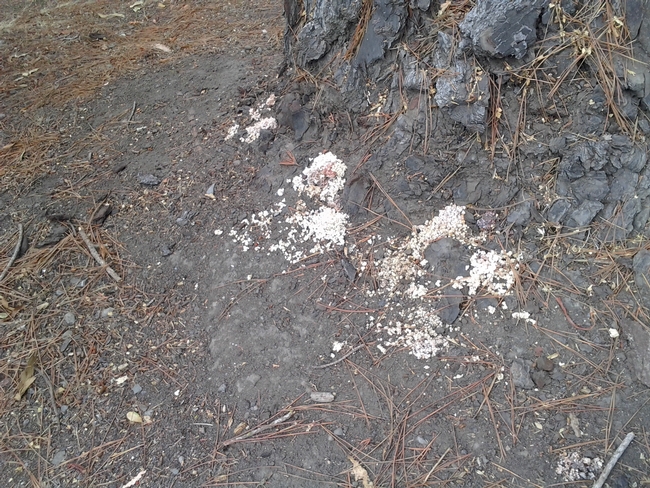Advice from the Help Desk of the UC Master Gardener Program
for Contra Costa County
When to Remove Garden Monterey Pines
Client's Request:I live in El Sobrante near the San Pablo Reservoir. On August 8th PG&E had a tree crew come to prune trees away from the power lines. They did a rather drastic prune on our very large Monterey pine tree (which to this point has been very healthy with no signs of beetles or any other issues). The tree was large when we moved in ~30 years ago and was topped some time before that. It has been pruned by PG&E tree crews a number of times over the years but never to this extent.
About 2 weeks ago we started noticing a few small bits of what we think is dried pitch on the ground at the base of the tree. I didn't think too much of this as I assumed that it was falling from the cuts up high and I have not seen any sign of bugs. However, as you can see from the pictures taken on Sept 20th, there is quite a bit and now (starting about a week ago) some oozing of white/reddish pitch from the large roots. It does not look like there is anything coming from the trunk as high as I can see. The fresh cuts were dripping pitch, but it looks clear.
Is this in response to the prune or is there a problem that I cannot see? Your thoughts and suggestions would be greatly appreciated.
MGCC Help Desk Response: Thank you for contacting the UC Masters Gardener Program Help Desk with your question about the pitch oozing from the roots of your Monterey pine. And thank you very much for the photos. They are very helpful.
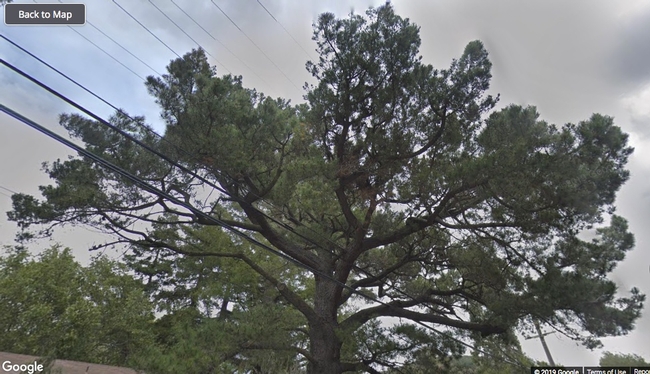
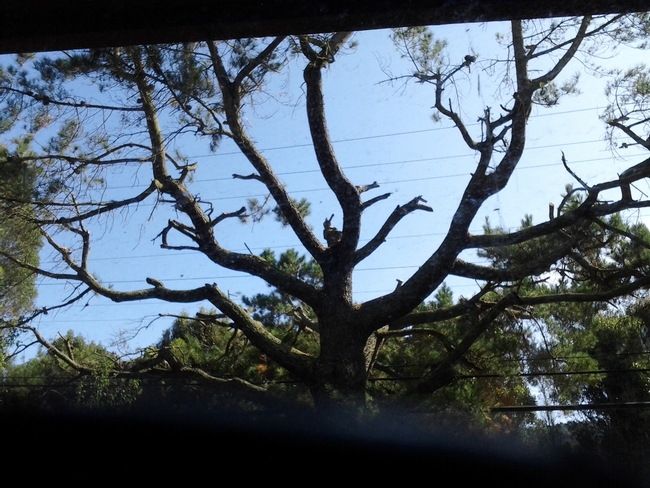
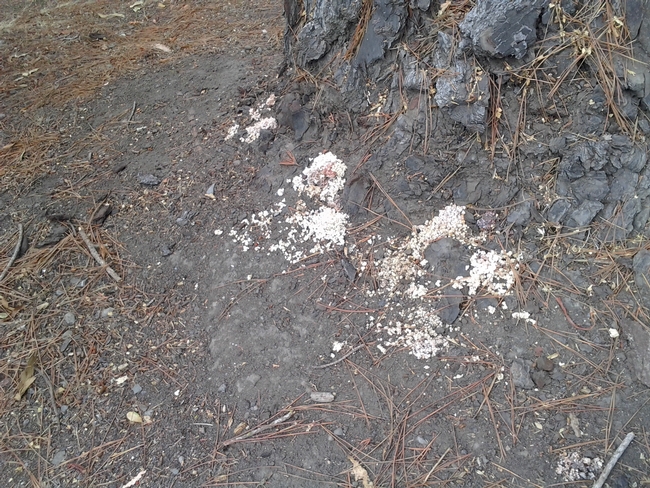
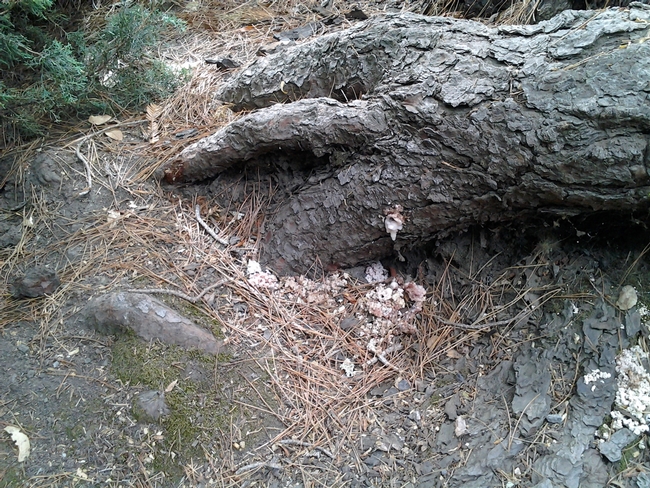
From the photos, I believe that the pitch you are seeing is the result of a bark beetle, most likely the red turpentine beetle, and not from the direct pruning cuts.
Bark beetles in general cause their damage when adults bore into the inner bark of trees where they lay their eggs. After the eggs hatch, the resulting larvae mine galleries that branch out from the egg-laying gallery. These larval mines are very narrow at first but increase in diameter as the larvae grow. All of this boring activity can start a flow of tree sap from pitch tubes. That flow may be accompanied by a sawdust-like frass. The sap and frass are the materials that you are seeing on the top of your roots.
Red turpentine beetles in particular are quite common in landscape Monterey pines. The pinkish to white pitch tubes on the lower trunk of standing trees are also characteristic of red turpentine beetles.
Healthy pines can generally tolerate a minor attack from a few beetles. Trees most likely to show signs of damage are those that are stressed by injuries or that may be declining due to old age. That means that you may be seeing signs of damage now due to a combination of the extensive pruning (or any other damage that may have occurred) and its age. Monterey pines generally live to only 45 to 50 years in inland climates.
Unfortunately, except for general cultural practices that improve tree vigor, little can be done to control most bark beetles once trees have been attacked. Because the beetles are under the bark, insecticides are rarely successful. You may want to monitor the tree for small entrance holes in the bark and increasing damage overall. If the main trunk is extensively attacked by bark beetles, the entire tree may have to be removed.
For more information on bark beetles, see http://ipm.ucanr.edu/PMG/PESTNOTES/pn7421.html
Please let us know if you have further questions or would like additional information.
Good luck with your tree!
| HOrTCOCO Editor's add-on comments…Living in the same house and garden for the last 50 plus years, bought on a VA guaranteed loan, and coming new with bare dirt (mostly rock known as Martinez Massive Sandstone) and a tree (Fruitless Mulberry and an already dying lightly seeded front lawn and all the rest bare dirt and about 1/3 of it bare slopes (supposedly covered with erosion control plants), I soon planted on the slopes over 100 Monterey Pine seedlings at about 10 cents each irrigated with their own dripper. They grew fairly well but starting around 20 plus years the drippers each were at least half gone from squirrels and other problems including a few bark beetles. The neighborhood kids liked the jungle effect. By year 30 the bark beetles were having a steady impact every year, notably probably weakened from several drougths which basically set them up for bark beetle attacks. Meanwhile it should be noticed that many home owners in the subdivision had also planted Monterey Pines (inexpensive, but found to be too large, not being properly maintained or watered, etc.) and most were suffering the same problems mainly because of the beetles and not maintaining proper irrigation. One time during the later years I wasn't out in my garden much during the winter months because of weather was home and the largest Monterey (50ft) turned from green to brown in 30 days. My adjacent neighbor was not appreciative of the brown (large) Monterey adjacent to the fence and his house and managed to get the Fire District to send me a warning letter over the possible situation. Within the next 30 days I hired an “arborist” (and his family) who proceeded to cut and remove the 23 Monterey Pines remaining (ranging in size from 12” to 30” trunk diameter). One of the larger Pines completely broke off about head high during the “removal”, luckily the “arborists” weren't on site… I'm still thinking about that. I'm still here and I'm still looking at the back hill and the one lonely pine that survives, but that turns out to be a Japanese Black Pine a neighbor gave me when I also planted all the Montereys. |
Help Desk of the UC Master Gardener Program of Contra Costa County (ECS)
Notes: Contra Costa MG's Help Desk is available almost year-round to answer your gardening questions. Except for a few holidays (e.g., last 2 weeks December), we're open every week, Monday through Thursday for walk-ins from 9:00 am to Noon at 2380 Bisso Lane, Concord, CA 94520. We can also be reached via telephone: (925) 608-6683, email: ccmg@ucanr.edu, or on the web at http://ccmg.ucanr.edu/Ask_Us/. MGCC Blogs can be found at http://ccmg.edu/HortCoCo/. You can also subscribe to the Blog.
